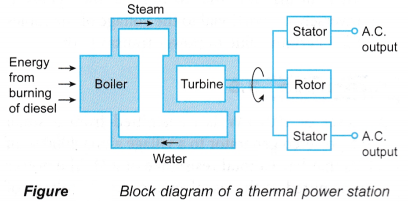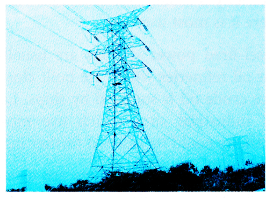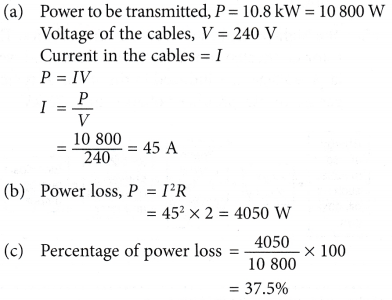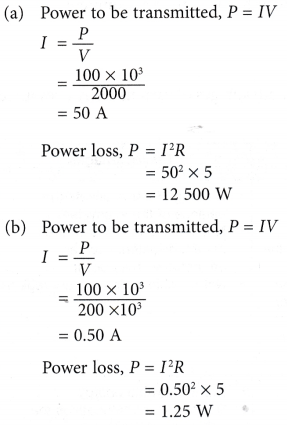How is electricity generated in a power station?

- Electricity generated at power stations uses the same principle as the electricity produced by a bicycle dynamo, that is, electromagnetic induction.
- The huge generator at a power station is also known as an alternator. The electromagnets (the rotor) are rotated by turbines while the coils and iron core (the stator) are at rest.
- Figure shows a block diagram for the generation of electricity in a thermal power station that uses a non-renewable energy resource.

- The heat energy from the burning of oil, diesel or coal is used to produce high-pressure steam in a boiler.
- The high-pressure steam rotates the turbines. The rotor connected to the turbines rotates and very large voltages are induced in the stator. A typical generator can produce voltages up to 25 kV.
- Figure gives a block diagram of the energy conversion in the generation of electricity at a thermal power station.

- The mechanism to rotate the turbines changes according to the type of energy resource used in the power station. In a hydroelectric power station, the kinetic energy of fast flowing water turn the turbines, as shown in Figure.

- Figure gives a block diagram of the energy conversion in the generation of electricity at a hydroelectric power station.

People also ask
- What are the Sources of Energy?
- What are the Non Conventional Energy Resources?
- What are the Conventional Energy Resources?
- Advantages and Disadvantages of Electricity Generation
- What is Nuclear Energy?
- What is nuclear fission and how does it occur?
- How is energy released in a nuclear fusion reaction?
- What happens in a nuclear chain reaction?
- How does a nuclear power plant works?
- What are the pros of nuclear energy?
- What are the disadvantages of using nuclear energy?
- Importance of Proper Management of Radioactive Substances
How electricity is transmitted and distributed?
The Transmission of Electricity:
- Electricity is usually not generated near to places where it is most used.
- Diesel-fired power stations are usually located near oil refineries which are built close to ports since crude oil is supplied by ships. Large cities and industrial sites which use most of the electricity could be situated further inland.
- Hydroelectric power stations are usually found in hilly regions. In Peninsula Malaysia, a remote region in Northern Perak and Kelantan has at least seven power stations, as shown in Figure. These power stations are far from the major cities and towns.

- Electrical energy is transmitted from the power station to the consumer using long transmission cables.
- The heating effect due to the resistance of the cables causes loss of electrical energy as heat energy. When a current, I flows in a cable, the power loss through heating is:

- The power loss can be reduced by:
(a) Reducing the resistance of the cables
(b) Reducing the current in the cables

- The resistance of the cables is reduced by using thicker cables or better conducting materials. However this gives rise to other problems.
(a) Cables that are too thick are very expensive to install.
(b) The cables will be very heavy and stronger pylons need to be constructed to support the cables securely.
(c) It is not economical to use very good conductors like copper or gold. - Power cables are made of aluminium because:
(a) It is a good conductor of electricity.
(b) It has a lower density. Cables made of aluminium are lighter.
(c) It is less expensive. - The loss of power in the transmission of electricity is reduced by reducing the current in the cables.
- The power to be transmitted by the cables is given by:

- The current in the cables:
 This means that the current in the cables is inversely proportional to the voltage of the cables for a certain value of power transmission.
This means that the current in the cables is inversely proportional to the voltage of the cables for a certain value of power transmission. - (a) When power is transmitted at a lower voltage, the current in the cables is large.
(b) The larger the current in the cables, the larger the power loss. - When electrical power is transmitted over long distances, the cables are at very high voltage so that:
(a) The current in the cables is smaller
(b) The loss of power due to heating of the cables is minimised - The use of transformers help to reduce the loss of power during the transmission of electricity.
- A step-up transformer steps up the voltage before the electrical power is transmitted by the cables. The power is transmitted with a smaller current. Therefore the loss of power is reduced.
- A step-down transformer steps down the voltage so that power is delivered at a voltage that is suitable to operate electrical devices used by consumers.
- The use of transformers in the transmission of electricity means that alternating current has to be used. This is because transformers can only step up and step down alternating current voltages.
Study the Model of Electricity Transmission Experiment
Aim: To study the model of electricity transmission.
Materials Insulated eureka wire (s.w.g. 30) to be used as transmission lines, connecting wires
Apparatus: A 1 : 20 step-up transformer, a 20:1 step-down transformer, four 12 V 24 W bulbs, two sets of a.c. power supply, four retort stands, power line terminal rods
Method:


- The apparatus is set up as shown in Figure.
- The 12 V a.c. power supplies in model A and model B are switched on.
- The brightness of the bulbs at the “power station” end and the “residential area” end are compared for models A and B.
Observation:

Discussion:
- The brightness of the bulb at the “power station” end indicates the amount of power supplied by the power station to the transmission lines.
The brightness of the bulb at the “residential area” end indicates the amount of power delivered by the transmission lines to the residential area. - The transmission lines of model B are at a higher voltage than model A.
- Model B transmits electricity .with less loss of power to the residential area.
Conclusion:
Electricity is transmitted with less loss of power when the transmission lines are at a higher voltage.
How is electricity distributed through the national grid?
The National Grid Network
- The power stations in our country are spread over different locations. Diesel-fired power stations (like the Tuanku Jaafar Power Station in Port Dickson) are situated near the ports. Hydroelectric power stations (like the Chenderoh Lake Power Station) are located deep inland.
- The National Grid Network is a network of cables which connect all the power stations in the country to the consumers in a closed network. It is similar to the system of roads that connect all the cities, towns and villages in the country. The cables are supported by strong steel structures known as pylons.
- All the power stations deliver electrical power into the National Grid Network. At the Control Centres, engineers direct the distribution of the power to the consumers throughout the country.
- Figure shows part of the National Grid Network. The electricity that is generated at 25 kV is stepped up to 275 kV to be sent over long distances. The very high voltage is stepped down in stages by substation transformers to local consumers.

- In year 1995, the 500 kV transmission system was designed and constructed. This is the single largest transmission system to be ever developed in Malaysia, with cables running from Gurun, Kedah to Pasir Gudang in Johor covering a distance of more than 500 km.
Why is the national grid needed
The advantages of the National Grid Network:
- Reduces power loss during transmission
The voltage is increased before transmission. This reduces the current and hence reduces the energy lost during transmission. - More stable and reliable supply of electricity
This ensures a continuous supply of electrical energy to the whole country. - Distribution of electricity to different users according to voltage requirement
Transformers are used to step down the voltage to levels according to the needs of the consumers. Heavy industries are supplied with 33 kV or 11 kV while homes are supplied with 240 V. - Maintenance and repairs on power stations, cables and pylons can be done at anytime
This is because a power station can be shut down without affecting users in other areas.
General Power Transmission Problems & Solutions
- 100 kW of electrical power is to be transmitted by cables which have a total resistance of 5 Ω. Calculate the power loss due to heating of the cables if the power is transmitted at a voltage of
(a) 2000 V,
(b) 200 kV.
Solution:

- A power of 10.8 kW is transmitted from a small wind-powered generator to a village along 4000 m of cables that have a total resistance of 2 Ω. The power is transmitted at the usual mains supply voltage of 240 V.
Calculate
(a) the current in the cables
(b) the loss of power due to the heating of the cables
(c) the percentage of power loss
Solution:

